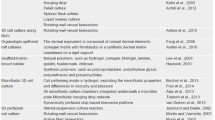Abstract
Representative, reproducible, and high-throughput models of human cells and tissues are critical for a meaningful evaluation of host–pathogen interactions and are an essential component of the research developmental pipeline. The most informative infection models—animals, organ explants, and human trials—are not suited for extensive evaluation of pathogenesis mechanisms and screening of candidate drugs. At the other extreme, more cost-effective and accessible infection models such as conventional cell culture and static coculture may not capture physiological and three-dimensional (3-D) aspects of tissue biology that are important in assessing pathogenesis, effectiveness, and cytotoxicity of therapeutics. Our lab has used innovative bioengineering technology to establish biologically meaningful 3-D models of human tissues that recapitulate many aspects of the differentiated structure and function of the parental tissue in vivo, and we have applied these models to study infectious disease. We have established a variety of different 3-D models that are currently being used in infection studies—including small intestine, colon, lung, placenta, bladder, periodontal ligament, and neuronal models. Published work from our lab has shown that our 3-D models respond to infection with bacterial and viral pathogens in ways that reflect the infection process in vivo. By virtue of their physiological relevance, 3-D cell cultures may also hold significant potential as models to provide insight into the neuropathogenesis of HIV infection. Furthermore, the experimental flexibility, reproducibility, cost efficiency, and high-throughput platform afforded by these 3-D models may have important implications for the design and development of drugs with which to effectively treat neurological complications of HIV infection.




Similar content being viewed by others
References
Abbott A (2003) Biology’s new dimension. Nature 424:870–872
Carterson AJ, Höner zu Bentrup K, Ott CM, Clarke MS, Vanderburg CR, Buchanan KL, Pierson DL, Nickerson CA, Schurr MJ (2005) A549 lung epithelial cells grown as three-dimensional aggregates: alternative tissue culture model for Pseudomonas aeruginosa pathogenesis. Infect Immun 73:1129–1140
Duray PH, Yin SR, Ito Y, Bezrukov L, Cox C, Cho MS, Fitzgerald W, Dorward D, Zimmerberg J, Margolis L (2005) Invasion of human tissue ex vivo by Borrelia burgdorferi. J Infect Dis 191:1747–1754
Höner zu Bentrup K, Ramamurthy R, Ott CM, Emami K, Nelman-Gonzalez M, Wilson JW, Richter EG, Goodwin TJ, Alexander SJ, Pierson DL, Pellis N, Buchanan KL, Nickerson CA (2006) Three-dimensional organotypic models of human colonic epithelium to study the early stages of enteric salmonellosis. Microbes Infect 8(7):1813–1825
LaMarca HL, Ott CM, Höner Zu Bentrup K, Leblanc CL, Pierson DL, Nelson AB, Scandurro AB, Whitley GS, Nickerson CA, Morris CA (2005) Three-dimensional growth of extravillous cytotrophoblasts promotes differentiation and invasion. Placenta 26:709–720
Long JP, Pierson S, Hughes JH (1999) Suppression of Epstein–Barr virus reactivation in lymphoblastoid cells cultured in simulated microgravity. In Vitro Cell Dev Biol 35(1):49–54
Nickerson CA, Ott CM (2004) A new dimension in modeling infectious disease. ASM News 70:169–175
Nickerson CA, Goodwin TJ, Terlonge J, Ott CM, Buchanan KL, Uicker WC, Emami K, LeBlanc CL, Ramamurthy R, Clarke MS, Vanderburg CR, Hammond T, Pierson DL (2001) Three-dimensional tissue assemblies: novel models for the study of Salmonella enterica serovar Typhimurium pathogenesis. Infect Immun 69:7106–7120
Nickerson CA, Ott CM, Wilson JW, Ramamurthy R, Pierson DL (2004) Microbial responses to microgravity and other low-shear environments. Microbiol Mol Biol Rev 68:345–361
O’Brien LE, Zegers MM, Mostov KE (2002) Opinion: building epithelial architecture: insights from three-dimensional culture models. Nat Rev Mol Cell Biol 3:531–537
Schmeichel KL, Bissell MJ (2003) Modeling tissue-specific signaling and organ function in three dimensions. J Cell Sci 116:2377–2388
Smith YC, Grande KK, Rasmussen SB, O’Brien AD(2006) Novel three-dimensional organoid model for evaluation of the interaction of uropathogenic Escherichia coli with terminally differentiated human urothelial cells. Infect Immun 74:750–757
Straub, T., Höner zu Bentrup, K., Mayer, B., Bartholomew, R., Valdez, C., Bruckner-Lea, C., Dohnalkova, A., Orosz Coghlan, P., Gerba, C., Abbaszdegan, M., and C.A. Nickerson (2006) First Report of In vitro infection of a 3-Dimensional Organoid Model of Human Small Intestinal Epithelium with Human Noroviruses Emerging Infectious Diseases. Accepted
Unsworth BR, Lelkes PI (1998) Growing tissues in microgravity. Nat Med 4:901–907
Zhang S (2004) Beyond the petri dish. Nat Biotechnol 22:151–152
Author information
Authors and Affiliations
Corresponding author
Rights and permissions
About this article
Cite this article
Nickerson, C.A., Richter, E.G. & Ott, C.M. Studying Host–Pathogen Interactions in 3-D: Organotypic Models for Infectious Disease and Drug Development. Jrnl Neuroimmune Pharm 2, 26–31 (2007). https://doi.org/10.1007/s11481-006-9047-x
Received:
Accepted:
Published:
Issue Date:
DOI: https://doi.org/10.1007/s11481-006-9047-x




